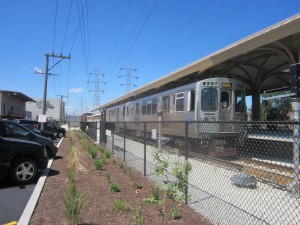CTA continues to works on faster commutes
George Castle — November 23, 2015Yellow Line reopening, Purple Line Express work aids effort
With the Yellow Line’s re-opening and track work ongoing to speed Purple Line Express service, north suburban commuters on the CTA could realize rush-hour goals of downtown-Skokie trips in an hour or less, given perfect connections.
However, the dream of a true CTA express train from Howard to downtown will remain just that due to the transit agency’s main north-south trunk line having reached capacity, according to a CTA spokesman.
Although the CTA cannot begin one- or two-stop service from the Howard station to downtown, the agency did look into expanding Purple Line express service just after the evening rush hour last summer. However, the pilot program of another train in the 8 p.m. hour last summer did not justify a permanent place on the CTA schedule due to low ridership numbers, spokesman Jeff Tolman added.
The appeal of a relatively speedy el trip from the north suburbs into the city has been proved by Wrigley Field-bound fans for night games in recent years, prior to the Yellow Line’s shutdown during the 2015 season due to an embankment collapse.
The fans would hop the Yellow Line at the Dempster Street station for the 10-minute trip to change to the Purple Line Express at Howard. If the fans made quick connections, they could get to Wrigley Field in half an hour as the Purple Line Express made special stops at the Sheridan and Addison stations in the few hours prior to night games The Purple line normally runs non-stop between Howard and the Belmont station.
The travel time and cost undercut that of auto trips from Skokie to Wrigley Field, factoring in the higher gas prices of the time and very expensive parking around the ballpark. Even Milwaukee Brewers fans heard about the fast, relatively cheap el trip, exiting the nearby Edens Expressway to park their cars for $3 in the Dempster lot when their favorite team visited Wrigley Field.
The Yellow Line connection to Wrigley Field travel proved so popular over the last two decades that the 4800 block of Skokie’s Elm Street had no-parking signs for nonresidents for the night games 14 miles away. The block contains many three-flat apartment buildings and normally tight on-street parking. Elm Street lies just beyond the end of the Dempster lot, so some Yellow Line-bound fans had desired to save the lot fee to park free.
But extending the quick travel all the way downtown via a true express train is not feasible with the present Red Line-dominated track structure.
The Purple Line Express, attracting 13,000 riders daily, is really only a partial nonstop line. A morning and evening rush-hour extension of service otherwise operated in just Evanston and Wilmette, the line makes all stops on the Brown Line leg south of Belmont. That slows the Loop-bound trip from a gallop to a crawl.
“It’s our busiest rail branch and is currently at maximum capacity,” Tolman said of the Red Line track layout, which also carries the Purple Line Express and Brown Line between the rail junction north of Belmont through Armitage, beyond which the 72-year-old Red Line subway begins.
Never say never, though. The CTA just re-instituted express-bus service on the Western and Ashland lines, and the No. 11 Lincoln Avenue bus, whose cancellation evoked local protests.
But when commuters were given the chance to prove their desire for expanded faster service, they did not respond as hoped with the pilot Purple Line Express train after the evening rush hour.
“We were seeing if there was a demand for a late-evening ridership on the Purple express,” Tolman said. “It didn’t meet what we felt would justify making it a permanent service. That’s just one instance where we’re constantly looking at our services and ways to improve.”
Existing Purple Line Express travel will speed up after work to upgrade the tracks from Howard to Lawrence is completed by year’s end. The last time the tracks were improved was the early 1970s.
“The track infrastructure will be much improved and we’ll eliminate several slow zones that are currently holding up trains in the area,” said Tolman.
Travel times should be further cut once the CTA completes the planned “fly-over” for Brown Line trains over the main Red Line just north of the Belmont station.
“It’s basically like a stop sign in the middle of the highway,” Tolman said. “All the tracks from the Purple, Red and Brown converge into one area, which requires the trains to stop and proceed one at a time.
A faster way of reaching downtown than the Red Line has been a goal of many longtime CTA commuters. In addition to often-jammed trains, the CTA’s busiest line makes every stop. Stations north of Wilson Avenue are often just three or fewer blocks apart.
In the mid-20th century, however, travel was faster as the Red Line, then called the Howard el, had “A” and “B” trains that made alternate stops. Only busy main-street stations served as stops for both trains.
— CTA continues to works on faster commutes —




